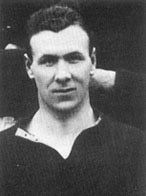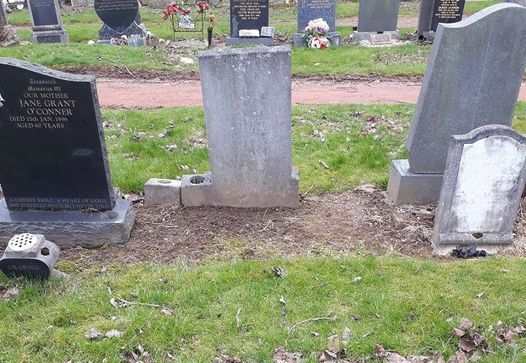Tom Bradshaw

Big, strong and imposing Thomas "Tom" Bradshaw was ideal for the nickname "Tiny". He must also be one of the most successful one-cap-wonders ever. Brought in to "do a job" on Dixie Dean in the 1928 Wembley Wizards game, one which he did stunningly, he was by thirty years a "man before his time"; Scottish, a centre-back, but not a Scottish centre-half. And that, when it came to future, international selection, was for him the problem. He was Woodburn, albeit more disciplined, a Greig, a Buchan or McLeish, not a Meiklejohn or a Simpson, Raisbeck, Cowan or Kelly.
"Tiny" Bradshaw was born in 1904 in Bishopton in Renfrewshire, by Erskine. His father was an agricultural labourer, a ploughman, born in Johnstone, his mother a lassie from the Highlands, who had come down into domestic service. But the family soon moved to Coatbridge and it was there that Tom, the middle of five sons, grew up and learned his football. At seventeen he was working as a labourer in the steel-works, living on Woodside St. and turning out for Woodside Juveniles and it was then that he was spotted by the manager of Bury, also a Coatbridge-man, "Kilty" Cameron, who, coincidently or not, shared a surname or even possible origins with Tom's mother.
Cameron signed Bradshaw. It was 1922, the young man was eighteen and, whilst it took a year for Tom to get into the First Team, once there at the end of the first season it would win promotion to Division One and the following campaign finish fifth and then in 1926 fourth. Thus it was, having played no senior football in his native country, he came to the notice of the Scottish selectors. They, prior to the arrival of Bob Campbell as President of the Scottish Football Association, had already in 1925-6 tinkered with replacing the traditional, Scottish play-maker centre-half with taller, more defensive proto-centre-backs but never against the Auld Enemy. But, after defeat to England at Hampden the previous year and coming on the back of one also to Ireland ,Campbell,, now also chair of the selection committee, took the plunge albeit in very specific circumstances. And to do so he, as it transpired as a one-off, turned to Tom Bradshaw.
Now, whether Tom would have played for Scotland again is a moot-point. However, his case was not helped because for the first half of the next season he was in any case side-lined by injury. Indeed Bury would be relegated. But for him at least the drop would not be for long. In early 1930, he not quite yet twenty-six, Liverpool signed him and, as the club, like others down South, seemingly made the change to the style of play by then used so successfully by Herbert Chapman's Arsenal, he was to remain at Anfield for eight years, captaining in that time, making almost three hundred starts.
However, outwith his football career little more is known about Tom Bradshaw. He left Liverpool in 1938. He served in the RAF during the war, after which he coached in Holland and then scouted for Norwich City, perhaps by then already having returned to Scotland and to Coatbridge. For it is there in Monklands Hospital that he would in 1986 pass away at the age of eighty-two, the last surviving member of that Wembley Wizards' team. He does not seem to have married and is buried, unacknowledged, his grave in Old Monklands Cemetery unmarked.
Birth Locator:
1904 - Hatton, Bishopton, Renfrewshire
Residence Locations:
1911-21 - 50c, Woodside St., Coatbridge, Lanarkshire
1939 - 83, Bankfield Rd., Liverpool
1986 - N/A
Death Locator:
1986 - Monklands Hospital, Coatbridge, Lanarkshire
Grave Locator:
Old Monkland Cemetery, Coatbridge, Lanarkshire
Back to Johnstone & Paisley,
the Cart Trails
or the SFHG Home page
